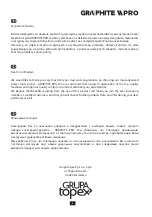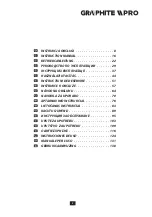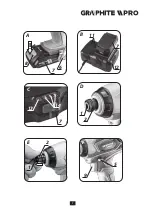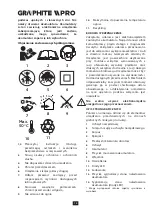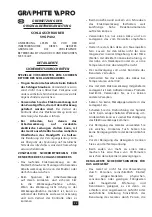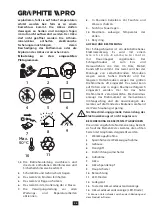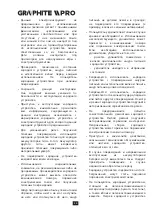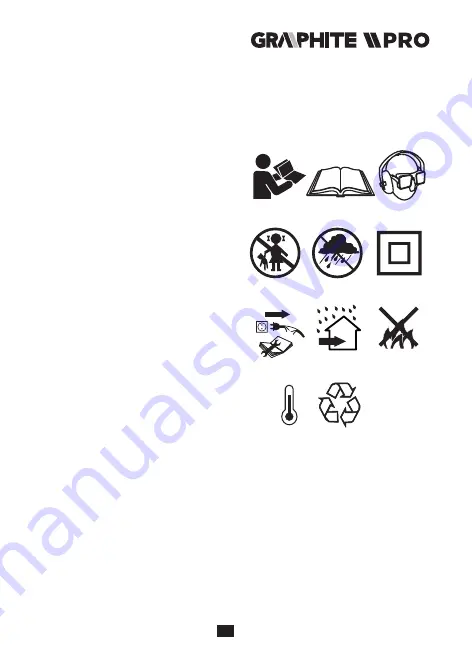
17
•
Use of any connecting elements not
supplied or not recommended by the
manufacturer of the charger may cause fire,
personal injury or electric shock.
•
Make sure the power cord is not located in a
pathway, is not exposed to treading or other
danger (e.g. strong tension).
•
Do not use extension cord unless absolutely
necessary. Use of improper extension cord
may cause fire or electric shock. When it is
necessary to use extension cord, first make
sure that:
- Extension cord socket matches plug
prongs of the original charger power cord.
- Extension cord is in good technical
condition.
•
Do not use the charger with damaged cord
or plug. Damage should be repaired by a
qualified person.
•
Do not use the charger after it has been hit,
dropped or otherwise damaged. Entrust the
testing and potential repair to an authorized
service workshop.
•
Do not try to disassemble the charger. All
repairs should be made by an authorized
service workshop. Improper charger
assembly may cause electric shock or fire.
•
Disconnect the charger from power supply
before starting any maintenance or cleaning.
•
In case of battery damage or improper use
it may produce gas. When it occurs, ventilate
room and seek medical attention in case of
medical symptoms.
•
Keep the charger clean. Dirt can be the
cause of electric shock.
•
Do not use charger when placed on
flammable surface (e.g. paper, textiles)
or in proximity of flammable substance.
Greater charger temperature when charging
increases risk of fire.
When the charger is not in use, it should be
disconnected from mains network.
CAUTION! This device is designed to operate
indoors.
The design is assumed to be safe, protection
measures and additional safety systems are
used, nevertheless there is always a small
risk of injuries at work.
Li-ion batteries may leak, set on fire or
explode when heated to high temperature or
short-circuited. Do not store the batteries in
a car in hot and sunny days. Do not open the
battery. Li-ion batteries contain electronic
protection devices that, if damaged, may
cause fire or explosion of the battery.
Explanation of used symbols
1
6
2
3
7
8
9
10
11
5
4
Max.
50°C
1,2.
Read the instruction manual, observe
warnings and safety conditions therein.
3.
Use protective goggles and hearing
protectors.
4.
Keep the tool away from children.
5.
Protect against rain.
6.
Device with class II insulation.
7.
Disconnect the power cord before starting
maintenance or repair.
8.
Use indoors, protect from water and
moisture.
9.
Do not throw into fire.
10.
Maximum permissible cell temperature.
11.
Recycling
Summary of Contents for 59GP402
Page 2: ...2...
Page 4: ...4...
Page 6: ...6 2 1 10 9 8 3 5 4 6 7...
Page 7: ...7 A 8 8 PRESS A 7 6 B 11 7 12 C 13 14 7 D 2 1 E 2 1 F 9 5...
Page 29: ...29 59GP402 50o C 0o C 30...
Page 30: ...30 Li Ion...
Page 31: ...31 Li Ion Li Ion 1 6 2 3 7 8 9 10 11 5 4 Max 50 C 1 2 3 4 5 6 II 7 8 9 10 11 1...
Page 34: ...34 2 E 1 2 2 D 5 F 5 5 5 5 3 6...
Page 37: ...37 59GP402 50o C 0 C 30...
Page 38: ...38...
Page 39: ...39 1 6 2 3 7 8 9 10 11 5 4 Max 50 C 1 2 3 4 5 6 7 8 9 10 11 Recykling 1 2 3...
Page 42: ...42 2 D 5 F 5 5 5 5 3 6 18 Li Ion 2500 A USB Power Bank 5 1...
Page 96: ...96 50o C 0o C 30...
Page 97: ...97...
Page 101: ...101 5 F 5 5 5 5 3 6 18V DC Li Ion 2500 mAh USB Power Bank 5 V DC 1A 2800 min 1 6 35 mm 165 Nm...
Page 116: ...116 59GP402 50 C 0o C 30...
Page 117: ...117 Li Ion...
Page 118: ...118 Li ion Li Ion 1 6 2 3 7 8 9 10 11 5 4 Max 50 C 1 2 3 4 5 6 II 7 8 9 10 11...
Page 121: ...121 9 LED 10 9 2 E 1 2 2 D 5 F 5 5 5 5 3 6...
Page 145: ...145...
Page 146: ...146...
Page 147: ...147...
Page 148: ...graphite pl...

